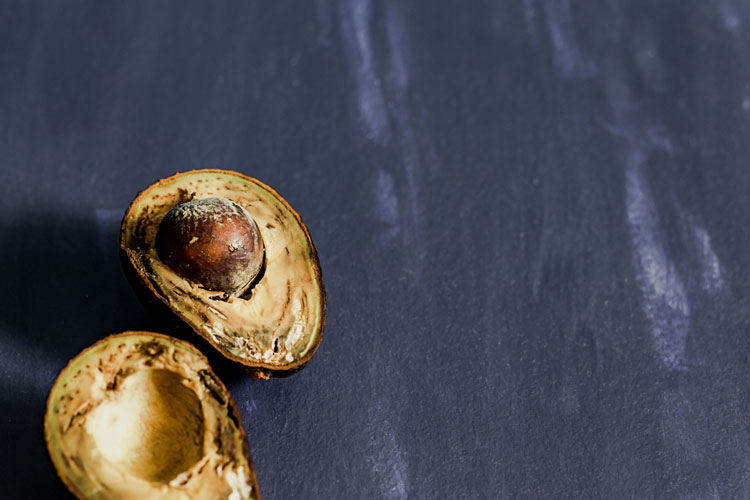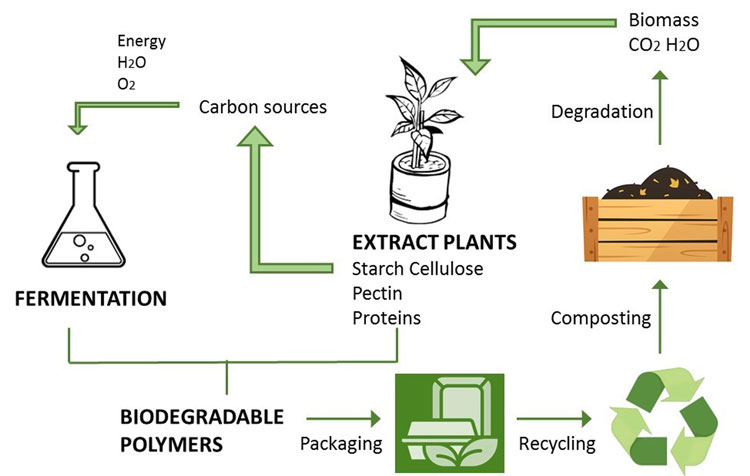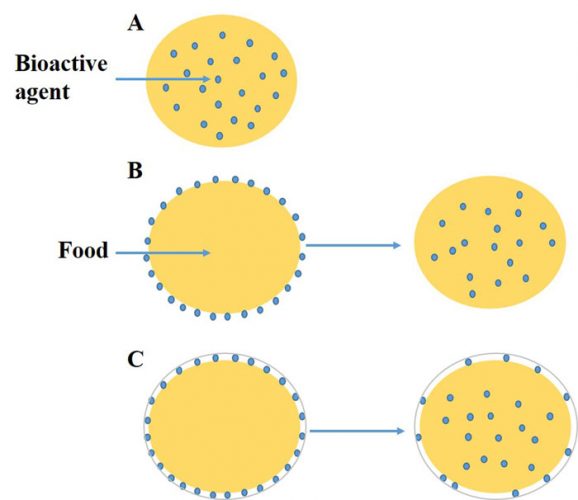Antimicrobial packaging
- Like
- Digg
- Del
- Tumblr
- VKontakte
- Buffer
- Love This
- Odnoklassniki
- Meneame
- Blogger
- Amazon
- Yahoo Mail
- Gmail
- AOL
- Newsvine
- HackerNews
- Evernote
- MySpace
- Mail.ru
- Viadeo
- Line
- Comments
- Yummly
- SMS
- Viber
- Telegram
- Subscribe
- Skype
- Facebook Messenger
- Kakao
- LiveJournal
- Yammer
- Edgar
- Fintel
- Mix
- Instapaper
- Copy Link
Posted: 5 November 2020 | Clelia Covino | No comments yet
How can antimicrobial packaging benefit food safety and the environment? Clelia Covino, PhD student, explains the inner workings and advantages…


Interest in the production of food packaging from biodegradable materials is constantly increasing across the globe. Consumers demand products that are environmentally friendly, safer and nontoxic. Today, almost all food is packaged for sale to the consumer. Food packaging is essential for the preservation and protection of food from contamination. The use of biodegradable polymers means we can avoid synthetic materials which are difficult to dispose of and recycle.


Figure 1: Cyclic process of biodegradable polymers
In order to decrease the volume of agro-waste, polymers can be extracted from plant resources. Biodegradable polymers are defined as materials that are capable of decomposition into carbon dioxide, methane, water, inorganic compounds, or biomass predominantly by the enzymatic action of microorganisms (Figure 1). Several biopolymers such as starch, cellulose, chitosan, PLA, PCL, PHB etc., are used for packaging sector.1 The ASTM standard D6400-04 is a test used to measure degradation activity of materials made from plastics which have been designed to be composted.2
Besides their biodegradability, biopolymers have other characteristics, such as air permeability, low temperature ‘sealability’, availability, and cost. Moreover, natural polymers can have a positive effect on delaying deterioration, extending shelf life, and preserving quality and food safety.
Interest in the production of food packaging from biodegradable materials is constantly increasing across the globe. Consumers demand products that are environmentally friendly, safer and nontoxic. Today, almost all food is packaged for sale to the consumer. Food packaging is essential for the preservation and protection of food from contamination. The use of biodegradable polymers means we can avoid synthetic materials which are difficult to dispose of and recycle.


Figure 1: Cyclic process of biodegradable polymers
In order to decrease the volume of agro-waste, polymers can be extracted from plant resources. Biodegradable polymers are defined as materials that are capable of decomposition into carbon dioxide, methane, water, inorganic compounds, or biomass predominantly by the enzymatic action of microorganisms (Figure 1). Several biopolymers such as starch, cellulose, chitosan, PLA, PCL, PHB etc., are used for packaging sector.1 The ASTM standard D6400-04 is a test used to measure degradation activity of materials made from plastics which have been designed to be composted.2
Besides their biodegradability, biopolymers have other characteristics, such as air permeability, low temperature ‘sealability’, availability, and cost. Moreover, natural polymers can have a positive effect on delaying deterioration, extending shelf life, and preserving quality and food safety.
What causes food deterioration?
It is well known that the cause of food deterioration is microbial growth. In daily life, food spoilage and deterioration are mainly caused by foodborne pathogens and other microorganisms, such as Campylobacter, Salmonella, Yersinia enterocolitica, Escherichia coli and Listeria monocytogenes, which mainly grow on food surfaces. Antimicrobial substances, such as bactericidal or fungicidal, can be added to food to ensure hygiene and food safety. The direct application of these substances has limited action due to the way it is applied, ie, via spraying or dripping onto food surfaces.
How antimicrobials can help protect food
An alternative form of protection is the use of antimicrobial compounds into the packaging material (Figure 2). A relatively new concept called ‘active packaging’ or ‘intelligent packaging’ has been introduced to provide interaction between food and packaging materials and to maintain a microenvironment.
As it has been defined in Article 3 of the CE No. 450/2009 Regulation, “Active materials and articles means materials and articles that are intended to extend the shelf life or to maintain or improve the condition of packaged food; they are designed to deliberately incorporate components that would release or absorb substances into or from the packaged food or the environment surrounding the food”.3 This way, packages not only act as a barrier between the food and the environment, but they also play an active role in its quality and shelf life.
Active components can be included in the package material as an additive in the polymer matrix or on the package surface, applied as a coating. Direct contact between the active polymer and the food is required. Their mechanism of action is slow release and migration in the packaged headspace or into the food product during storage and distribution. Thus, contamination can be limited and microbial growth inhibited.
Along with playing a key role in preservation, incorporating these substances into films can also have positive effect on the food surface, which is more susceptible to microbial growth. Without mixing active compounds directly with food, this kind of active packaging can reduce the development and spread of spoilage and pathogenic microorganisms.4
Antimicrobial films can be divided into three categories according to their mode of production:
- Incorporation of antimicrobial substances into a sachet connected to the package from which the volatile bioactive substance is released during further storage
- Direct incorporation of the antimicrobial agent into the packaging film
- Coating of the packaging with a matrix that acts as a carrier for the antimicrobial agent.
These categories of materials can release the antimicrobial agents onto the surface of the food. The antimicrobial agents may either be released through evaporation in the headspace (volatile substances) or migrate into the food (non‐volatile additives) via diffusion. This is more efficient than direct application of the antimicrobial agent onto food surfaces because it slows the migration of the agents away from the surface, helping to maintain high concentrations where they are needed.
Antimicrobial agents for alternative and sustainable packaging
Many antimicrobial substances are sorbates, benzoates and parabens, permitted by FDA regulations. Potassium sorbate is known to inhibit the growth of mould, bacteria and yeasts and can therefore be used in antimicrobial packaging.5 The most studied substances are organic acids or their salts (acetic, benzoic, sorbic, citric, and propionic acids), enzymes (lysozyme and glucose oxidase), proteins (nisin andpediocin), and metals (silver, copper, and zirconium). Volatile antimicrobial substances, such as SO2, ClO2 or ethanol, may be incorporated into packaging materials, inhibiting microbial and fungal growth.6


Figure 2: Types of incorporation of active agents in food products and consequences: incorporation in the food (A), dipping (B), incorporation into a film (C). Blue points showed the action of the antimicrobial compounds
Metals, glass and paper are utilised to produce antimicrobial packaging; however, polymeric materials are the most popular. Broadly, active materials are prepared from polyolefins, although an interest in the use of sustainable biopolymer is increased. These polymers can be non-degradable, eg, bio-polyethylene, which is obtained from ethanol from feedstocks after a dehydration process. Ethylene-vinyl alcohol copolymer (EVOH) is used as gas barrier polymer in the active materials, due to their hydrophilic character. Indeed, when these polymers are dried, they keep the active compounds inert into the matrix; whereas, when they are moist, the release of antimicrobial substances is activated.7 As mentioned before, biodegradable polymers from biomass are used in the green-based antimicrobial packaging materials such as cellulose, carrageenan, starch/polymers blend from polysaccharides, whey protein, casein, gluten from proteins, vegetable fat and oil from lipids.
PHA and PHB are renewable resources from microorganisms, whereas PLA is produced from biotechnology. The latter is usually a thermoplastic aliphatic polyester derived from renewable resources such as cornstarch.8
The conventional technologies used for the production of these packaging are extrusion and injection, allowing the incorporation of antimicrobial additives into the polymer matrix. Coating and printing technologies can also be used. In any case, the final material must have efficient ‘activity’ throughout the shelf life of the food.
Recently, nanofillers or nanopolymers have been employed to improve mechanical properties and increase water resistance of materials, and to control the release of active compounds.
A new antimicrobial multilayer material, based on a commercial packaging for food, has been developed using an innovative procedure to include the antimicrobial agent in the material. For this method, the antimicrobial substance is inside the adhesive layer that joins different laminating materials. The benefit is that cost of production should not rise, while the loss of the antimicrobial substance to the environment is prevented.9
Conclusion
Food packaging is very important to protect foods from bacterial infection. The potential of these technologies are evaluated to extend the shelf life and assure the innocuousness and preservation of food products. Although industrial applications are limited due to factors such as their oxygen/water vapour barriers, thermal resistance and mechanical properties, biodegradable food packaging is very promising because it is a ‘green’ process.
With the development of antimicrobial packaging materials, standards are needed to evaluate their antimicrobial activity and food safety. Antimicrobial packaging materials must be equipped with intelligent technology, such as indicators, to show the degree of bacterial contamination in food and to measure temperature, pH value and humidity of packaging microenvironment, and to control shelf life of food. The performance of antimicrobial packaging can be improved by studying the right synergy between substances and blending and using nanocomposites, thus avoiding the limits of antimicrobial active agents.
About the author
Clelia Covino
Clelia is a PhD student of Food Science at the Agriculture University of Naples, Federico II (Italy). In 2016, she completed her degree in Food Science and Technology at the same University. Clelia attended the Erasmus project for her Master thesis on ‘Polyphenoloxidase from Lactuca Sativa (var. iceberg): characterization and application in enzymatic biosensors for the detection of catechols’ at the Laboratory of Analytical Chemistry in Madrid Complutense University (Spain).
References
- Pawar PA, Aachal HP. (2013). Biodegradable polymers in food packaging. American Journal of Engineering Research 2(5), 151-164
- ASTM D6400-04 (2004). Standard Specification for Compostable Plastics. ASTM International, West Conshohocken, PA
- (EC) No. 450/2009 on active and intelligent materials and articles intended to come into contact with food.
- Coma V. (2008). Bioactive packaging technologies for extended shelf life of meat-based products. Meat Science 78, 90–103.
- Han JH, Floros JD. (1997). Casting Antimicrobial Packaging Films and Measuring Their Physical Properties and Antimicrobial Activity. Journal of Plastic Film and Sheeting 13, 287-298
- Appendini P. and Hotchkiss J. H. (2002) Review of antimicrobial food packaging. Innovative Food Science & Emerging Technologies 3(2), 113-126
- Catalá R., Muriel-Galet V., Cerisuelo J.P., Domínguez I., Carballo G.L., Hernández-Muñoz P. and Gavara R. (2016). Antimicrobial Active Packaging Systems Based on EVOH Copolymers. Antimicrobial Food Packaging 22, 297-303
- Zhong Y., Godwin P., Jin Y., Xiao H. (2020). Biodegradable polymers and green-based antimicrobial packaging materials: A mini-review. Advanced Industrial and Engineering Polymer Research 3, 27-35.
- Gherardi R., Becerril R., Nerin C., Bosetti O. (2016). Development of a multilayer antimicrobial packaging material for tomato puree using an innovative technology. Food Science and Technology 72, 361-367
Issue
Related topics
Food Safety, Food Waste, Lab techniques, Packaging & Labelling, Research & development, Sanitation, Shelf life, Technology & Innovation









